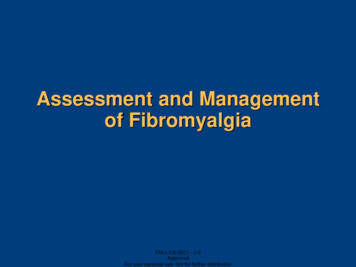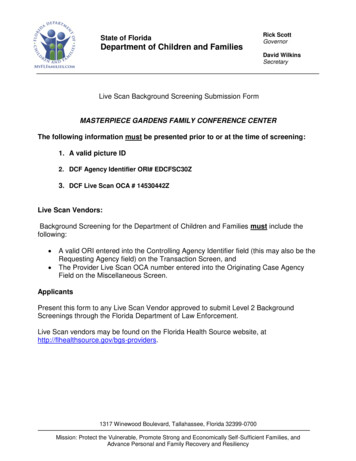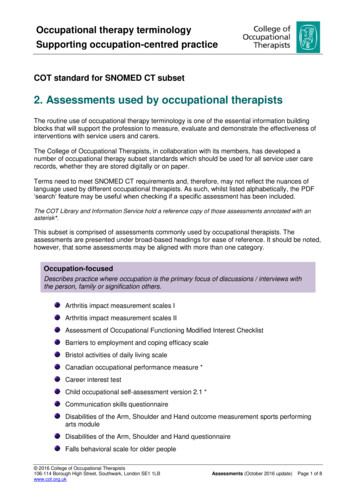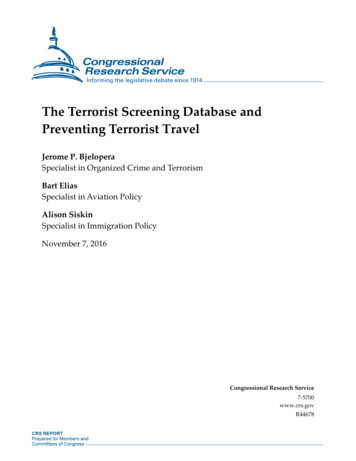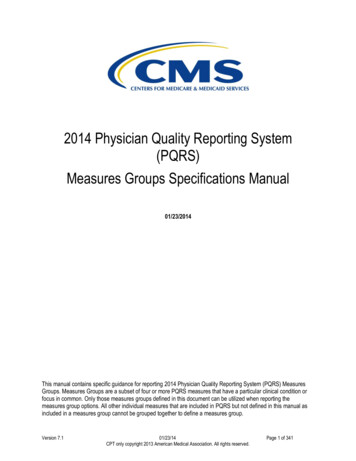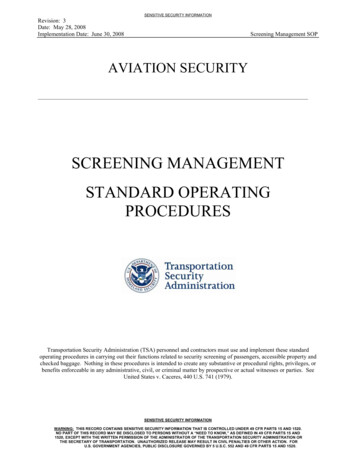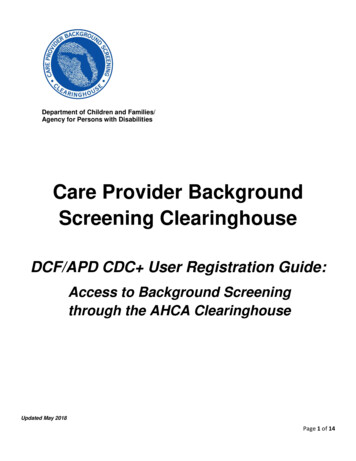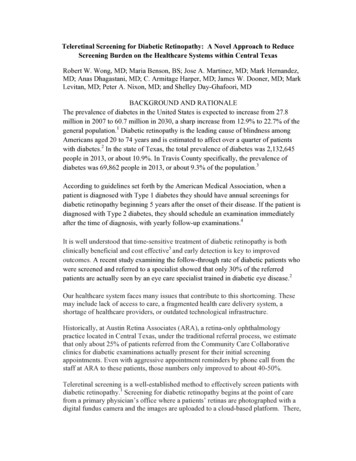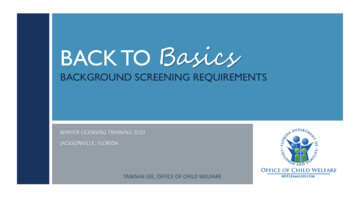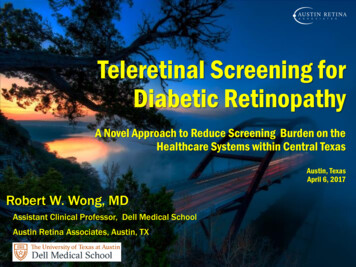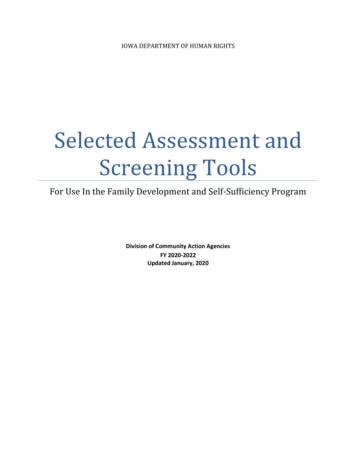
Transcription
IOWA DEPARTMENT OF HUMAN RIGHTSSelected Assessment andScreening ToolsFor Use In the Family Development and Self-Sufficiency ProgramDivision of Community Action AgenciesFY 2020-2022Updated January, 2020
Table of ContentsPurpose1Table of Selected Tools2Adult Education and EmploymentEmployment Hope ScaleLearning Needs Screening ToolPicture Interest Career Survey (PICS)8910Basic Needs and ServicesHunger Vital SignHomelessness Prevention & Diversion Assessment Tool1112Child Development and Parenting SkillsAges and Stages Questionnaire (ASQ-3)Ages and Stages Questionnaire: Social Emotional (ASQ:SE-2)Casey Life SkillsFamily Advocacy and Support Tool (FAST)13141516Domestic ViolenceRelationship Assessment Tool17Family FunctioningEcomapGenogramLife Skills ProgressionMeasure of Family Well-BeingNorth Carolina Family Assessment Scale - GeneralTimeline181920212223Health, Mental Health, and Substance AbuseAC-OK Screen for Co-Occurring DisordersCAGE and CAGE-AID QuestionnairesEdinburgh Postnatal Depression Scale (EPDS)Patient Health Questionnaire (PHQ-9)24252627Appendix AAssessment and Screening Protocol28Appendix BProtocol for Submission and Review of Tools32-2-[Typ
PurposeAssessment of a family’s strengths and needs is often the first task undertaken by a familydevelopment specialist and forms the basis by which the other FaDSS components, such as GoalSetting, Referrals and Collaboration, and Support are implemented. A combination of formaland informal approaches can be used to screen for and assess a number of focus areas,including general family functioning, mental health, adult learning needs, substance abuse,parenting and child development, and domestic violence.This document serves as a resource and guide for FaDSS programs to reference when selectingand implementing formal assessment tools. Where possible, information related to each tool’sgeneral purpose, target population, cost, training requirements, and accessibility has beenprovided. All of the tools selected for inclusion in this resource have some level of evidencebehind them. Many are known to be valid and reliable (referred to as evidence-based); some areresearch-informed (shown to be innovative or promising).Using the right assessment tool, administered in the correct way and at the right time, willimprove the likelihood that designated resources and/or services are suitable for the family’sneeds at a given point in time (Bloom et al., 2011; Pavetti, Derr & Martin, 2008; Williamson etal., 2011).11Hornby Zeller Associates, Inc., “Family Development and Self-Sufficiency ResearchCompendium for Program Core Components,” 2014.1
Table 1Selected Tools, By Area of oper /PublisherAdult Education and EmploymentEmployment Hope Scale (EHS21), Short Employment HopeScale (EHS-14), and PerceivedEmployment Barriers Scale(PEBS)EHS was originally designed tomeasure the state of a person’spsychological empowerment,motivation, skills and resources, andgoal-orientation as a factor inworkforce development.Low-incomejobseekers.None.None.Philip Young P. Hongand Choi, S. LoyolaUniversity Chicago.2013.Learning Needs Screening Tool(Adult)This two-page assessment tool isdesigned to help identify pastlearning difficulties that may affectthe ability of a person to obtainemployment. The questions addressissues such as simple arithmetic andspelling, as well as other familymembers’ learning experiences.Adult jobseekers;validated for usewith TANFpopulations.No informationavailable.No informationavailable.Payne & Associates,Northwest Center forthe Advancement ofLearning. Several stateshave adopted a versionof the Washington tool;several adaptations areavailable online.Picture Interest Picture InterestCareer Survey (PICS)PICS is a quick way for people toidentify occupational interests byusing pictures of people at workrather than text-based items.Based on the pictures selected, PICScreates a profile of the individualthat leads directly to careerinformation and potential jobmatches.Individuals with:Limited English;DevelopmentalDelays; LearningDisabilities; ChronicUnemployment;Limited EducationThere is no formaltraining required.There aredownloads availableon the website foradministration andscoring of theassessment.The package of 25assessments is 66.95. The onlineassessment key of25 assessments isalso 66.95.Robert P. Brady, Ed.D.A two-question food insecurityscreening tool based on theHousehold Food Security Scale. Thetool measures families’ concernsabout access to food.Young children andfamilies (universal).None.None.Children’s HealthWatch;Erin R. Hager, Anna M.Quigg, Maureen M.Black et. al.Basic NeedsHunger Vital Sign (FoodInsecurity Screen)2
ToolHomelessness Prevention &Diversion Assessment ToolOverviewAn assessment tool for use withfamilies at risk of homelessness. Thetool may be used to determine if afamily will need shelter or if theycan be assisted and housed withouthaving to enter the homelessassistance system.TargetPopulationTrainingCostDeveloper /PublisherFamilies (universal).None.None.National Alliance to EndHomelessness;Hennepin County, MN;Columbus YWCA (OH).Child Development and Parenting SkillsAges and Stages Questionnaires(ASQ-3)A parent/caregiver administeredscreening tool for development ofcommunication, gross motor, finemotor, problem solving, andpersonal-social skills. Materialsavailable in English, Spanish, andFrench.Children ages 1 to 66months.Training is available.A specialized,technicalbackground is notrequired toadminister thescreen. Trainingcosts vary (from 50to 3,500)depending on theformat (DVD orseminar).The Starter Kit isavailable forpurchase for 295.Additional copiesmay be purchasedfor 240.Developed by JaneSquires and DianeBricker. Published byPaul H. BrookesPublishing Co., Inc.Ages and Stages Questionnaires:Social-Emotional (ASQ:SE-2)A parent/caregiver administeredscreening tool for development ofself-regulation, compliance,communication, adaptivefunctioning, autonomy and affectinteraction with people. Materialsavailable in English and Spanish.Children ages 2 to 60months.Training is available.A specialized,technicalbackground is notrequired toadminister thescreen.The Starter Kit isavailable forpurchase for 295.Additional copiesmay be purchasedfor 240.Developed by JaneSquires, Diane Bricker,and Elizabeth Twombly.Published by Paul H.Brookes Publishing Co.,Inc.Casey Life SkillsA 113 item tool to assess skills,knowledge, and awareness in sevenareas (Daily Living, Self Care,Relationships and Communication,Housing and Money Management,Relationships and Communication,Career and Education Planning, andLooking Forward).Young adults ages 14to 21.No trainingspecified.The tool is availablefor download freeof cost.Nollan, K. A., Horn, M.,Downs, A. C., Pecora, P.J., & Bressani, R. V.(2002). Ansell-Casey LifeSkills Assessment(ACLSA) and LifeskillsGuidebook Manual.Seattle, WA: CaseyFamily Programs.[Typ3
ToolFamily Advocacy and SupportTool r /PublisherA 40 item tool assessing areasincluding familysystem/relationships, caregiver’sstatus, youth status, and caregiveradvocacy status. The tool may beused by programs to inform serviceintensity.Families; universal.Training andcertification arerecommended.The tool may beused by the publicat no cost.Contact: Susan Mitchell,Executive Director,Network DevelopmentDivision, TennesseeDepartment ofChildren’s Services,Nashville TN.The Relationship Assessment Tool(WEB) assesses for emotional abuseby measuring a woman’sperceptions of her vulnerability tophysical danger and loss of powerand control in her relationship.Adults; universal.Training is required.Contact Page Eastin,Iowa Department ofHuman Rights forfurther information.A 25 fee includesthe cost of trainingand use of theRelationshipAssessment Tool.Dr. Paige Hall. Publishedby Futures WithoutViolence.EcomapAn assessment, planning andintervention tool used to documentthe family unit’s relationship toexternal systems.Families; universal.None specified. TheNRCFCP providestraining on this toolas a component ofits n, A. 1975,University of MichiganSchool of Social Work.GenogramA tool used to describe and gaininsight into relationships and roleswithin the family, often spanningmultiple generations.Families; universal.None specified. TheNRCFCP providestraining on this toolas a component ofits FamilyDevelopmentCertificationTraining.None.Monica McGoldrick,Randy Gerson, 1985.Domestic ViolenceRelationship Assessment ToolFamily Functioning[Typ4
ToolLife Skills ProgressionMeasure of Family Well-BeingNorth Carolina FamilyAssessment of Strengths per /PublisherThe LSP is designed for use byprograms serving low incomeparents of children aged 0-3 years.The LSW utilizes 43 parent and childscales which describe a spectrum ofskills and abilities across domainssuch as relationships, education andemployment, parent and childhealth, mental health andsubstance use, and basic needs.A four-part series of tools assessingparenting and family well-being,housing, community life, food andnutrition, health and health care,education and jobs, money,transportation, children’seducation, children’s behavior andchild care.Families; universal.Training is required.Contact KellyDavydov, IowaDepartment ofHuman Rights forinformation on localtrainingopportunities.A fee of 49.95includes the LSPbook and digitalcopies of the tool.Costs for databaseuse and developersponsored trainingare available on thewebsite.Wollesen, L. and Peifer,K. For informationabout the tool, contactDr. Brad Richardson,Life Skills ProgressionCenter Director,University of Iowa.Families; universal.None specified.Free; in the publicdomain.1999, University ofGeorgia Family andConsumer Sciences,Adapted from Institutefor Family Support andDevelopment of MICA,1996.The NCFAS provides ratings offamily functioning on a six-pointscale ranging from “clear strengths”to “serious problems” in thefollowing five domains: (1)environment, (2) parentalcapabilities, (3) family interactions,(4) family safety, and (5) child wellbeing.Families; developedfor use in a childwelfare setting.Training is required;purchased withlicense to use theassessment tool.Online cost quoterequest is available.Developed by ReedAshcraft, Kirk, & Fraser,2001. Published byNational FamilyPreservation Network.[Typ5
ToolTimelineOverviewA tool used to observe the relevantevents experienced by the familyover a period of time.TargetPopulationTrainingCostDeveloper /PublisherFamilies; universal.None specified. TheNational ResourceCenter for FamilyCentered Practiceprovides training onthis tool as acomponent of itsFamily DevelopmentCertificationTraining.None.No informationavailable.Health, Mental Health, and Substance AbuseAC-OK Screen for Co-OccurringDisordersA rapid-response screeninginstrument designed to identify theco-existing disorders of mentalhealth and trauma related mentalhealth issues, and substance abuse.Adults.None specified.Free; in the publicdomain.Andrew L. Cherry,University of Oklahoma,2007.CAGE and CAGE-AIDQuestionnairesThe CAGE Questionnaire is a short,four question screen for alcoholabuse. The CAGE-AID is anadaptation of the original CAGEQuestionnaire and serves as ascreen for illicit drug use.Adults; originallyintended for use in aprimary health caresetting.None specified.Free; in the publicdomain.Dr. John Ewing,University of NorthCarolina at Chapel Hill.Edinburgh Postnatal DepressionScale (EPDS)The EPDS is designed to detectpostnatal depression in mothers 6-8weeks after delivery. It is a short(10-item) self-administered tooloriginally designed to identify thepresence of depression in womenfollowing childbirth, although it hasbeen used during pregnancy andother periods, including withfathers. The scale measuressymptoms of depression includingsadness, fear, anxiety, self-blame,Pregnant women ofany age and womenup to one yearpostpartum.None specified.Resources for homevisitation providedby the IowaPerinatal Project.None specified.Cox, Holden, Sagovsky,1987.[Typ6
and sleeping difficulties.Patient Health Questionnaire(PHQ – 9)The PHQ-9 is a brief (9-item) selfadministered tool designed toassess and monitor depressionseverity. Originally designed for usein a primary care setting, the toolhas been used in a variety ofsettings, including home visitation.Adults; universal.None specified.Free; in the publicdomain.[TypDrs. Robert L. Spitzer,Janet B.W. Williams,and Kurt Kroenke.7
Adult Education and EmploymentEmployment Hope Scale (EHS-21, EHS-14 and PEBS)OverviewThe Employment Hope Scale (EHS-21, EHS-14 and PEBS) family of tools was originally designed to measure anaspect of psychological self-sufficiency to complement the dominant paradigm of economic self-sufficiency inworkforce development. These client-centered measures capture the state of one’s psychologicalempowerment, futuristic motivation, skills and resources, and goal-orientation as a developmental process.The Employment Hope Scale (EHS), the lengthiest of these three tools at 21 questions, measures an individual’sself-worth, perceived capability, futuristic self-motivation, utilization of skills and resources, and goal orientationusing a 10 point scale.The Short Employment Hope Scale (EHS-14) uses a 10 point scale to identify an individual’s agreement with 14items related to psychological empowerment, futuristic self-motivation, utilization of skills and resources, andgoal orientation.The Perceived Employment Barriers Scale (PEBS) is a 20 item assessment of possible employment barriers,including physical and mental health, labor market exclusion, child care, human capital, and soft skills.Target PopulationIndividuals: female; male; limited skills/education; minorities – racial/ethnic; older workers; underemployed;unemployed; youth – out-of-school/drop-out.TrainingTraining is recommended, however none is specified.CostFree; in the public domain.Available at:http://ecommons.luc.edu/socialwork facpubs/25/.Further information is available icle 1027&context socialwork facpubs&seiredir 1&referer t%2BHope%2BScale%26src%3Die9tr#search %22Employment%20Hope%20Scale%22.8
Learning Needs Screening ToolOverviewThis two-page assessment tool is designed to help identify past learning difficulties that may affect the ability ofa person to obtain employment. The questions address issues such as simple arithmetic and spelling, as well asother family members’ learning experiences. The purpose of this tool is not to diagnose learning disabilities, butto identify resources and services that might help a person secure stable and meaningful employment.Target PopulationAdult jobseekers; TANF population.TrainingNo information available.CostNo information available.Available ult/files/docs/16010Learning Needs Screening Tool.pdf9
Picture Interest Career Survey (PICS)OverviewThe Picture Interest Picture Interest Career Survey (PICS) is a quick way for people to identify occupationalinterests by using pictures of people at work rather than text-based items.Individuals are presented with 36 sets of three pictures and choose which of the three portrayed occupationsseems most interesting. Based on the pictures selected, PICS creates a profile of the individual that leadsdirectly to career information and potential job matches.Target PopulationIndividuals with limited familiarity with English.Individuals who are developmentally delayed or have a learning disability.Individuals with limited access to education.Individuals who are chronically unemployed.TrainingThere is no formal training required. There are downloads available on the website for administration andscoring of the assessment.CostThese can be purchased in packets of 25 or purchase an online version. The package of 25 assessments is 66.95. The online assessment key of 25 assessments is also 66.95.Available at: st-career-survey.html10
Basic Needs and ServicesHunger Vital SignOverviewDrs. Erin Hager and Anna Quigg and the Children’s HealthWatch team validated the Hunger Vital Sign , a 2question screening tool, suitable for clinical or community outreach use, that identifies families with youngchildren as being at risk for food insecurity if they answer that either or both of the following two statements is‘often true’ or ‘sometimes true’ (vs. ‘never true’): “ Within the past 12 months we worried whether our food would run out before we got money to buymore.” “ Within the past 12 months the food we bought just didn’t last and we didn’t have money to get more.”Healthcare providers, social service providers, community-based outreach workers, teachers, and anyone whoworks with young children can use the Hunger Vital Sign to identify young children and families who may needassistance.Target PopulationYoung children and families (universal).TrainingNone specified.CostNone.Available uploads/FINAL-Hunger-Vital-Sign-4-pager1.pdf.11
Homelessness Prevention & Diversion Assessment ToolOverviewThis assessment tool, based on Minneapolis/Hennepin County, Minnesota’s and Columbus, Ohio’s assessmentforms, will be of use to communities attempting to determine if a household needs prevention or diversionassistance. This should be administered as soon as a household comes into an assessment center to determine ifthey will need shelter or if they can be assisted and housed without having to enter the homeless assistancesystem. The prevention segment of this tool should be tweaked based on the community’s data on its shelteredpopulation. Prevention assistance should be targeted to those households that most closely resemble thehouseholds already in shelter.Target PopulationFamilies at risk of homelessness.TrainingNone.CostNone.Available at:https://b.3cdn.net/naeh/b1438c09fd530d19b1 e1m6bn601.pdf12
Child Development and Parenting SkillsAges and Stages Questionnaires (ASQ-3)OverviewrdThe Ages and Stages Questionnaires-3 Edition (ASQ-3) is a developmental screening system made up of 21 agespecific questionnaires completed by parents or primary caregivers of young children. Each questionnaire can becompleted in 10-15 minutes. Completing a questionnaire independently requires reading skills at a 4 th to 6th gradelevel. If parents or caregivers are unable to complete questionnaires independently (due to cognitive disability,limited reading skills, etc.), teachers and program staff can provide support.The questionnaires can identify children who are in need of further assessment to determine whether they areeligible for early intervention or early childhood special education services. The ASQ-3 Information Summary sheetprovides a list of potential actions that may follow the screening, based on the child’s scores and the parent’sresponses to the overall questions. For example, if the child’s scores indicate typical development, children can berescreened at 4- to 6-month intervals, and parents can be given suggestions for activities to do with their childrento support their continued development. If a child’s scores indicate the need for further assessment, a referral to acommunity agency or specialist may be made.Target PopulationChildren ages 1 to 66 months.TrainingTraining DVDs are available that show staff how to screen, score, and interpret the results of the ASQ-3. Programsmay also arrange for onsite seminars or attend the training seminars held every year by the developers of ASQ-3.Costs associated with the seminars range from 2,500 to 3,500 while the training DVDs can be purchasedseparately for 55.00. Detailed information is available on the company’s website(http://www.agesandstages.com/training/). Contact the Division of Community Action Agencies - FaDSS Programfor a list of local trainers.CostThe ASQ-3 Starter Kit, which includes 21 paper masters of the questionnaires (in English or in Spanish), scoringsheets, a CD-ROM with printable PDF questionnaires, the ASQ-3 User’s Guide, and a laminated ASQ-3 Quick StartGuide, cost 295.00. The starter kit contains all 21 questionnaires. Additional copies of the 21 questionnaires (inEnglish or in Spanish) can be purchased separately for 240.00.Available /.13
Ages and Stages Questionnaires: Social-Emotional (ASQ:SE-2)OverviewThe Ages and Stages Questionnaires: Social-Emotional (ASQ:SE-2) is a developmental screener designed tocomplement the Ages and Stages Questionnaires by providing information specifically addressing the social andemotional behavior of children. The ASQ:SE-2 identifies infants and young children whose social or emotionaldevelopment requires further evaluation to determine if a referral for intervention services is necessary.The original ASQ:SE was developed as a parent-completed screening tool, and it is best that parents or caregiverscomplete the screeners. However, child care providers, teachers, and early interventionists can also complete theASQ:SE-2. Parents, caregivers, and teachers do not need to have technical training to complete the ASQ:SE.Target PopulationChildren 2 months to 60 months of age.TrainingTraining is available through the publisher on how to administer and score ASQ:SE-2. There are many differenttypes of training available including onsite seminars and training by DVD. Costs associated with the trainingseminars range from 2,500 to 3,500 while the training DVDs can be purchased separately for 55.00. Detailedinformation is available on the company’s website. http://www.agesandstages.com/training/. Contact the Divisionof Community Action Agencies - FaDSS Program for a list of local trainers.CostA complete ASQ:SE -2 Starter Kit costs 295.00. This kit contains everything needed to start screening children withthe ASQ:SE-2: eight photocopiable print masters of the questionnaires and scoring sheets, a CD-ROM withprintable PDF questionnaires, and the ASQ:SE-2 User's Guide. The Starter Kit is also available with Spanishquestionnaires. Additional master copies of the eight questionnaires (in English and Spanish) can be purchasedseparately for 175.00.Available e-2/.14
Casey Life SkillsOverviewThis measure consists of 113 items that assess skills, knowledge, and awareness in seven areas (Daily Living, SelfCare, Relationships and Communication, Housing and Money Management, Relationships and Communication,Career and Education Planning, and Looking Forward). The CLS-Youth was created specifically for adolescents andyoung adults living in foster care, but can be useful for other populations (including those involved in juvenilejustice facilities, employment centers, homeless shelters, and other social service providers). Additionally, themeasure was created with the goal of making it as free from gender, ethnic, and cultural biases as possible. Thismeasure is intended to be used with adolescents and young adults ages 14 to 21. Practitioners should allow 30-40minutes for a respondent to complete the entire measure. However, having respondents complete one area at atime is also appropriate. Both web-based and paper and pencil versions of this measure are available.The CLS-Youth can be used in its entirety as a measure of progress over long time intervals. Additionally, individualareas on the measure may be used alone as a post-assessment after a period of working on improving specificskills or as a repeated measure to assess progress in that area over time. The amount of time that should beallowed between assessments to gauge progress can vary depending on the adolescent’s or young adult’s needs,the service provider’s program requirements; monthly, quarterly, or annual assessments may be appropriate foreach individual set of circumstances.Target PopulationYoung adults ages 14 to 21.TrainingNone.CostNone.Available at:https://caseylifeskills.secure.force.com/15
Family Advocacy and Support Tool (FAST)OverviewThe Family Advocacy and Support Tool (FAST) is the family version of the Child and Adolescent Needs andStrengths (CANS) family of planning and outcome management tools. A large number of individuals havecollaborated in the development of the CANS and FAST instruments. Along with the CANS versions for individualyouth and caregivers, the FAST information integration and communication tool is designed to support family caseplanning. Additionally, the aggregate data can be used to evaluate, inform, and plan for each level of a family andchild-serving system.The FAST was originally developed to support case management activities in the child welfare system. The FASTversion illustrated here was developed by MJ Henry & Associates, Inc., to support families in-home by preventingchild welfare involvement and maintaining relational and legal permanency. The CANS and FAST are open domaintools for use in service delivery systems that address the child welfare and mental health of children, adolescents,and their families.Target PopulationFamilies; universal.TrainingTraining and certification are recommended. For more information, contact John S. Lyons, Ph.D., Mental HealthServices & Policy Program, Northwestern University, Chicago, IL. JSL329@northwestern.edu.CostNone.Available anuals/ (several versions are available for download; use of the“FAST - Casey Family Programs” tool and reference guide is recommended).16
Domestic ViolenceRelationship Assessment ToolOverviewThe Relationship Assessment Tool is a screening tool for intimate partner violence (IPV). This tool, developed byDr. Paige Hall and colleagues in the 1990’s, was originally named the WEB (Women’s Experiences with Battering).Terminology has since evolved in the field and the unique characteristic of this assessment tool which measureswomen’s experiences in abusive relationships is more accurately reflected by using the name RelationshipAssessment Tool.The Relationship Assessment Tool (WEB) assesses for emotional abuse by measuring a woman’s perceptions of hervulnerability to physical danger and loss of power and control in her relationship. Research has shown that the toolis a more sensitive and comprehensive screening tool for identifying IPV compared to other validated tools thatfocus primarily on physical assault.The tool is effective in identifying IPV among African-American and Caucasian women. The tool has not beenvalidated for use with same sex partners; however, it can be adapted for use with same sex couples by changing“he” to “my partner” in the screening tool.The tool can be self-administered or used during face-to-face assessment by a provider. A series of 10 statementsask a woman how safe she feels, physically and emotionally, in her relationship. The respondent is asked to ratehow much she agrees or disagrees with each of the statements using a 6 point scale. A score of 20 points or higheris considered positive for IPV.Target PopulationAdults; universal.TrainingTraining is required. Contact Page Eastin, Iowa Department of Human Rights for further information.CostA fee of 25 includes the cost of training and use of the Relationship Assessment Tool.Available at:A sample of the tool may be accessed at ool-and-universal-education/.17
Family FunctioningEcomapOverviewBased in Family Systems Theory, the Ecomap is an assessment, planning and intervention tool used to documentthe family unit’s relationship to outside systems. According to the tool’s developer, the Ecomap portrays anoverview of the family in their ecological situation; pictures the important nurturant or conflict-laden connectionsbetween the family and the world; demonstrates the flow of resources, or lacks and deprivations; and highlightsthe nature of the interfaces and points of conflicts to be mediated, bridges to be built, and resources to be soughtand mobilized.Target PopulationFamilies; universal.TrainingNone specified. The National Resource Center for Family Centered Practice provides training on this tool as acomponent of its Family Development Certification Training.CostNone.Available at:Sample Ecomaps are provided in Family Development Certification training materials. For further information, visithttp://clas.uiowa.edu/nrcfcp/.18
GenogramOverviewBased in Family Systems Theory, the Genogram provides a picture of the family system through time. It enables anindividual to step out of the system, examine it, and gain insight into complex family dynamics that havedeveloped over time and how they affect the current situation. The Genogram can provide an intergenerationalhistory that can assist in identifying extended family support systems. The Genogram is developed with the fullparticipation of the family.Target PopulationFamilies, Universal.TrainingNone specified. The National Resource Center for Family Centered Practice provides training on this tool as acomponent of its Family Development Certification Training.CostNone.Available at:Sample Genograms are provided in Family Development Certification training materials. For furtherinformation, visit http://clas.uiowa.edu/nrcfcp/.19
Life Skills ProgressionOverviewThe LSP is an outcome measurement instrument designed for use by programs serving low incomeparents of children aged 0-3 years, though it may be used to age 60 months. The LSW utilizes 43 parentand child scales which describe a spectrum of skills and abilities across domains such as relationships,education and employment, parent and child health, mental health and substance use, and basic needs.The tool can be used to collect outcomes data,
Casey Life Skills A 113 item tool to assess skills, knowledge, and awareness in seven areas (Daily Living, Self Care, Relationships and Communication, Housing and Money Management, Relationships and Communication, Career and Education Planning, and Looking Forward). Young adults ag

